Product marketing is the process of introducing a new product to a specific group of people who might want to buy it. It involves understanding who these potential customers are, explaining how the product can help solve their problems, and making sure the product stands out from similar products offered by competitors.
In a nutshell, effective product marketing ensures that the product meets market demands, stands out from competitors, and evolves based on user feedback.
Before launching a product, product marketers do several important things. They figure out who might buy the product and who the competitors are, decide who the product is for, create clear messages about the product, plan how and where it will be sold, and set goals to measure success. This way, everything is carefully planned and ready for a successful launch.
After the product is launched, the focus is on keeping people interested and making sure they use it. This includes telling customers about new features and updates, interacting with user communities, and offering clear instructions and learning materials to help them use the product effectively.
Product marketing also requires extensive internal communication. Product marketers ensure everyone at the company understands the target customers and the product’s core strengths. They create clear messages that everyone can use when talking about the product. The are often responsible for training the sales team on how to sell the product and keeps everyone updated on any changes or new features. This way, everyone in the company is on the same page and can effectively support the product.
In this article, you will learn all about product marketing: what it is, why it’s important, and how it works. We will break down the key roles and responsibilities of a product marketer, from understanding the target audience to crafting effective messaging and planning successful product launches.
You’ll also discover the differences between product marketing and other marketing roles, and get step-by-step guidance on how to execute a successful product marketing strategy. Additionally, we’ll share real-world examples and practical tips to help you apply these concepts effectively in your own work.
You can’t create and launch a successful product without product marketing. You can’t do that without knowing what to build and who to market the product to.
Example: Juicero.
Moreover, if you want to stand any chance of success in the market, you need to know how to efficiently position and communicate your product’s value to create demand among your target audience.
All the things mentioned above relate to product marketing. So if you were to become a product marketer, or hire one, what would the role entail? Let’s answer that too.
Here are some key areas of a product marketer’s role:
| What | Why |
|---|---|
| Market research | Among others: -Understanding customers’ needs and wants -Identifying opportunities in the market -Understanding the competition |
| Go-to-market strategy | Identifying what will be offered, to what market, at what price, how it will be offered, and what is required operationally to launch the product |
| Positioning and messaging | -Determining the benefits that the product should be identified with -Determining how to catch the attention of the target audience and educate them about the product |
| Product communication (external and internal) | -Externally: creating demand for the product by communicating its features and benefits -Internally: product education and making sure external communication is consistent |
| Marketing collateral | Creating the collection of media used to support the sales of the product (e.g., sales brochures, knowledge base articles, data sheets, demos) |
| Gathering user feedback | -Understanding how satisfied users are with the product -Suggesting improvements in the product and how it’s delivered to the market |
| Product analytics | Understanding how users engage with the product, e.g., feature usage, points of friction, user retention |
| New feature launches | Delivering new features to the market and driving their adoption |
| Reputation management | -Replying to reviews -Fact-checking 3rd-party publishers to make sure data/screenshots are up to date |
It may sound obvious, but it’s worth knowing that a product marketer doesn’t need to do all of those things. Those tasks can be divided among multiple marketers, even different roles.
At Ahrefs, much of what our marketing department does is product marketing. Yet only a handful of team members are engaged with the product enough to be known as “product marketers.”
To make things a bit clearer, this is what we (a company with over 100 people) expect from a product marketer:

Some things on that list are not exclusive to a product marketer in our marketing team. For example, most of us are involved in creating product-led content. However, a specific “mix” of those duties makes it a good fit for a product marketer specialization.
Product marketing is essentially a subdivision of marketing. Doing product marketing is basically doing marketing that’s focused on everything directly related to making a product successful in the market. And that responsibility has been a part of marketing since the conception of the four Ps of marketing (product, price, place, and promotion).
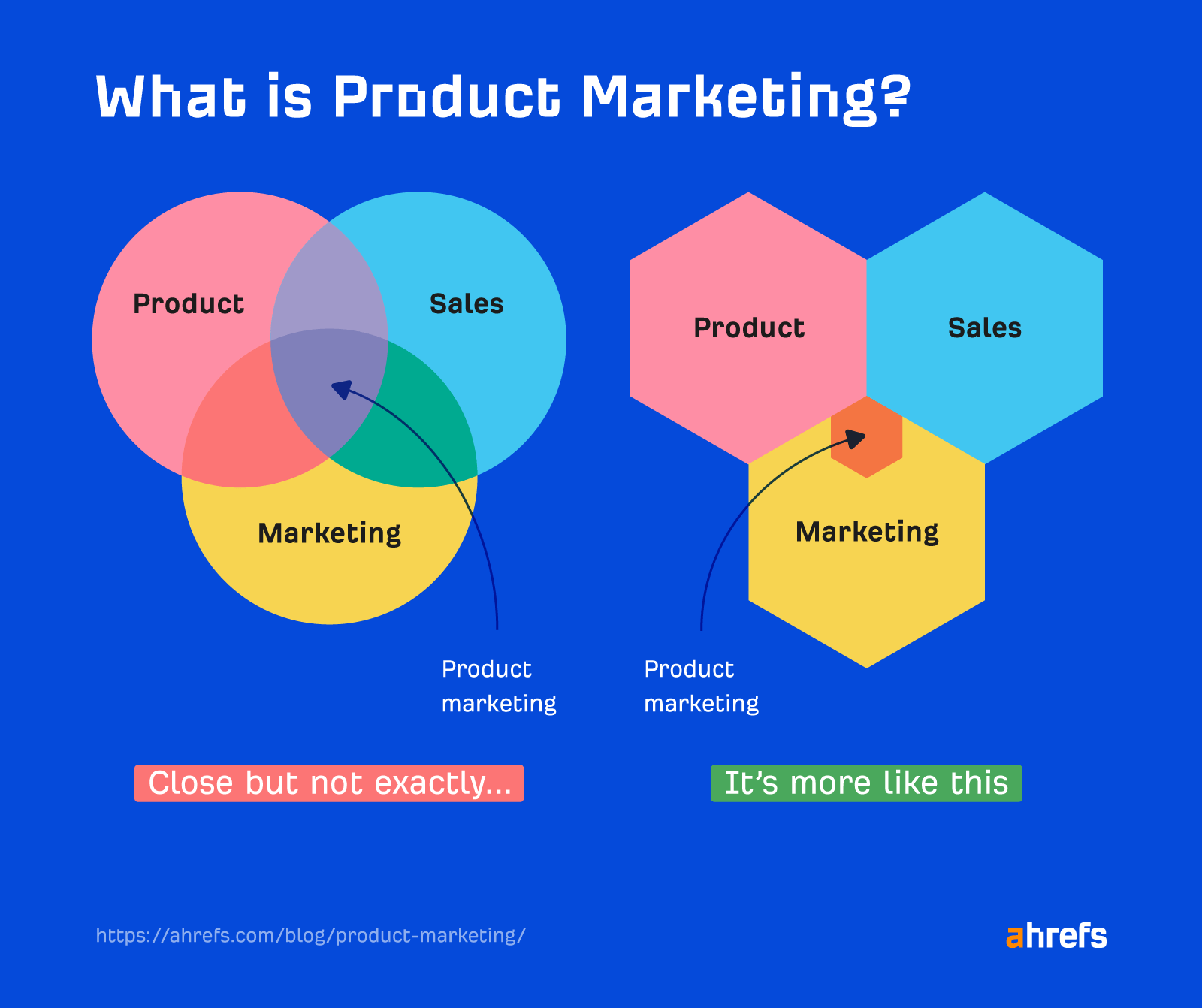
Roughly speaking, product marketers differ from other marketing roles by:
- Having a more direct influence on the product.
- Doing a lot of market research.
- Focusing on outbound marketing tools.
- Their KPIs are mostly short term.
The next closest marketing function is growth marketing (but growth marketing is another word for “everything” especially in startups). Here’s a quick comparison between product marketing and some common marketing roles:
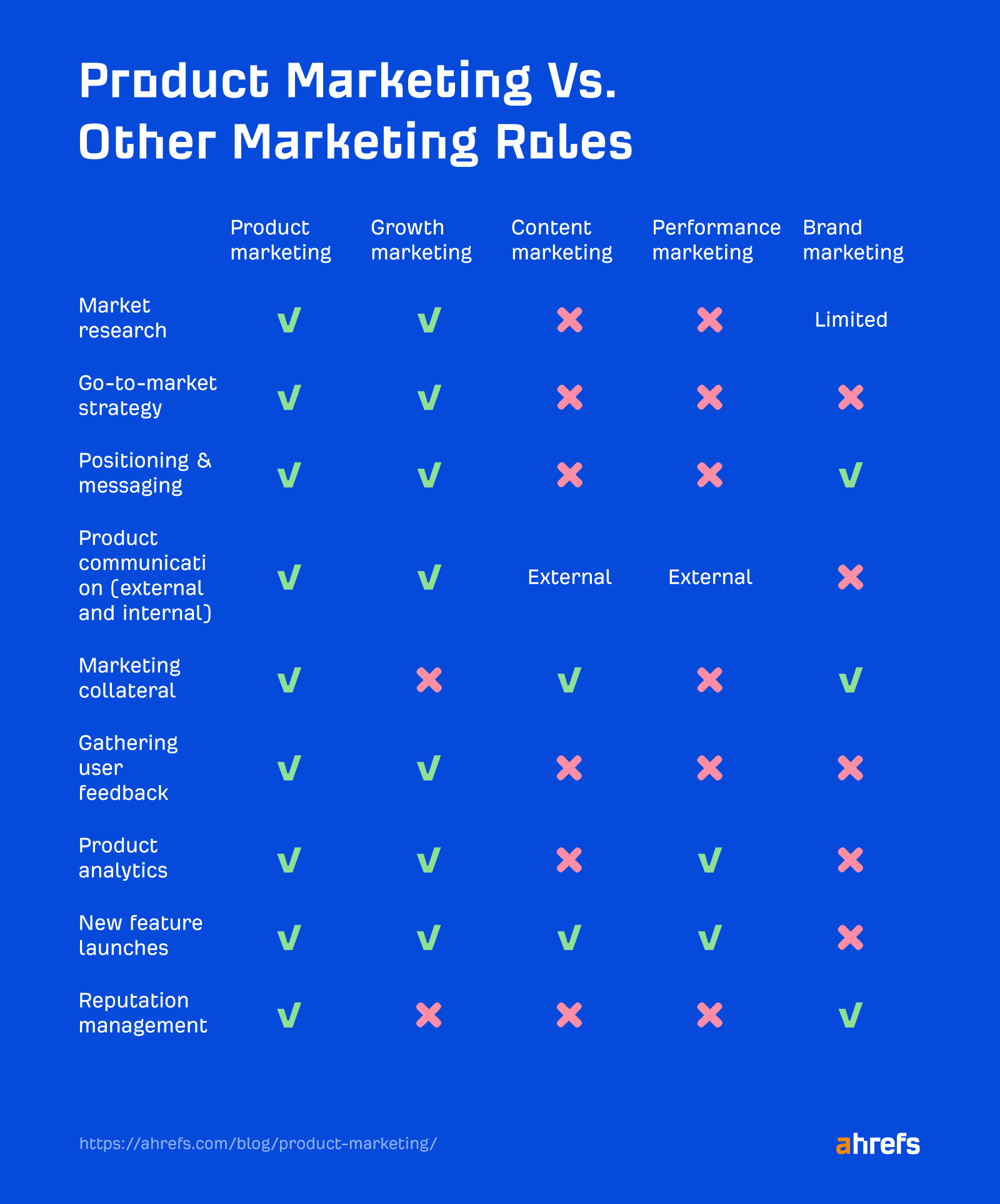
Here are the main steps product marketers usually take to bring products to the market. I’ll explain how to market a product chronologically: before the product launch and after the product launch.
Pre-launch stage
This stage can be summed up with one concept: go-to-market strategy (GTM strategy). A GTM strategy is basically a company’s plan to introduce a new product or service to the market. Typically, product marketers own these strategies.
Here are the eight steps in the GTM process, along with the vital questions they help to answer:
- Identify your market (along with your competitors) – This is the product’s “environment” for growth. What opportunities are there? Who will you be playing “against”?
- Identify your customer – Who are you trying to sell to? How will your product make people’s lives better?
- Define product positioning and price – How should your product be perceived by the target audience? Are you offering more benefits for a lower price or maybe more benefits for a higher price?
- Define product messaging and core marketing tactics – What do you say to potential customers to sell your product? What marketing channels can you use to reach them?
- Define product distribution – How will a user access your product? Directly or maybe through distributors?
- Sync marketing, sales, and support – What do sales, support, and other marketing team members need from you to make this product a success? And what do you need from them?
- Determine the budget, time frame, and resources needed – Time, resources, and money: How much will the product launch consume?
- Define your success metrics – How will you know you have achieved product-market fit? How will you measure growth?
If you’d like to read more on the topic of GTM strategies, head over to this guide.
Post-launch stage
After the product launch, product marketers will be involved in the following activities. (Note that they are ongoing activities and not necessarily performed in this order.)
- Internal and external product communication – A product marketer’s goal is twofold here: demand generation and product adoption. The first is about attracting visitors to the product; the latter is about helping users use product features to accomplish their goals.
- Product analytics – Product marketers don’t need to guess how users engage with the product. They can track this with analytics software (e.g., Mixpanel, Heap).
- Gathering user feedback – This is how product marketers can perform an important role of being the customer’s advocate. Knowing which remarks to prioritize and which to ignore is an art in itself. But it can lead to dramatic improvements within the product.
- Feature launches – Product marketers devise communication and coordinate feature launches using various marketing channels.
That’s about it when it comes to basic theory on marketing a product. Let’s see some examples of how all these can be put into practice.
Here are seven tried and tested ideas on how to promote a product and increase product adoption.
But before we go any further, here’s an important rule about product marketing: make sure you achieve product-market fit before investing time and money in promoting it. Promoting a product nobody wants or can afford is a losing game.
1. Blogging with product-led content
Blogging and SEO can be great allies for product marketers. You can use blog posts to show how your product solves real problems and reach people looking for solutions on Google.
This kind of content drives both product demand and product adoption; it generates traffic to your website and shows people how to use the product at the same time.
To implement this tactic you need topics with traffic potential and a scoring system to prioritize topics that allow you to feature your product naturally. We’re explaining how to find these topics in our beginner’s guide to keyword research and as for the scoring system, feel free to use our business potential scoring.
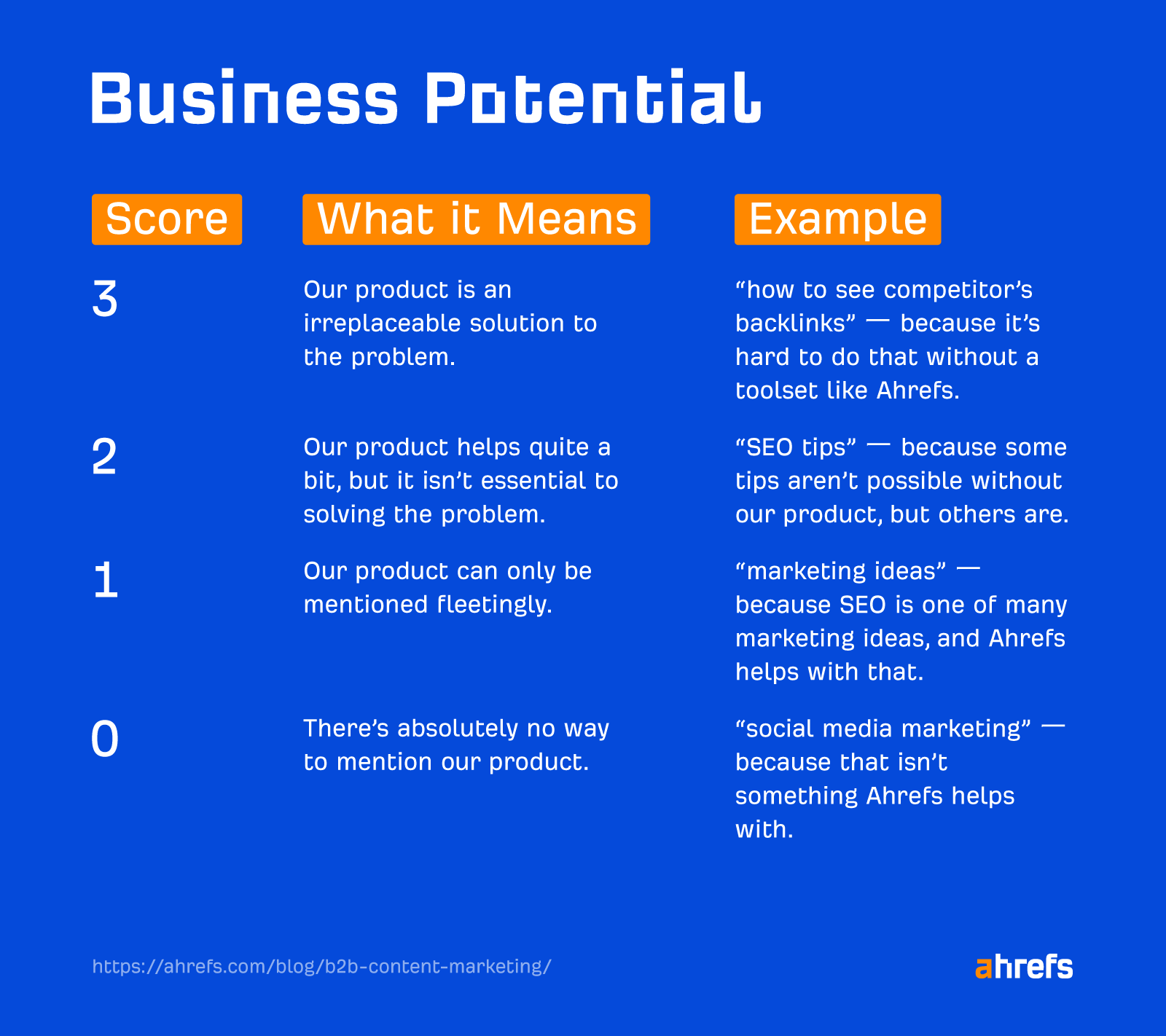
The scoring system works like this: prioritize topics that score at least “1” on the business potential (BP) scale. In other words, the BP scale expresses our ability to feature Ahrefs inside the content naturally.
So in our example, to show how people can uncover organic keywords otherwise hidden in Google Analytics, we’ve featured Ahrefs Webmaster Tools as one of the solutions.
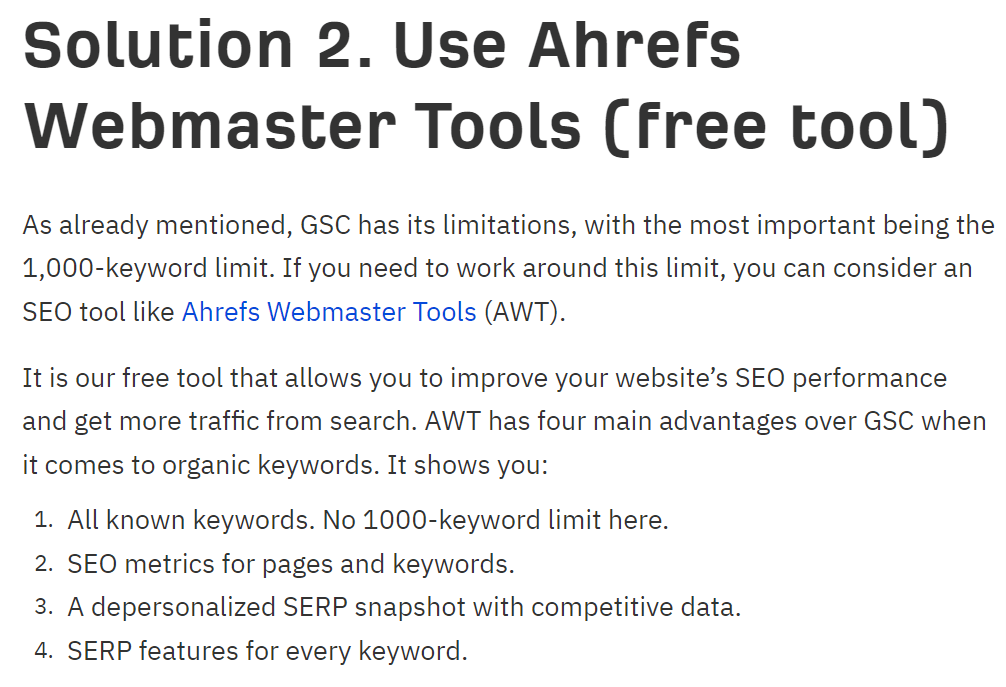
We use the same tactic in video content creation. Here’s the same principle but in the context of a different topic and a different part of our product offer.
2. Product feature launches
We’re constantly working on making our product even better. This means launching new features and data updates quite often (over 130 product updates in 2023).
I love how quickly @ahrefs pushes good product updates. 👏
— Andrew Charlton (@bertiecharlton) September 13, 2021
This is 🔥 https://t.co/T9YlZpUa1j
In this area of marketing a product, we try to make sure our announcements are as visible as they can be. In order to do that, we communicate the product through various channels:
- Product blog
- Social media
- Product newsletter
- Ads
- Facebook Insider group (exclusive for our customers)
- PR (for bigger announcements)
- Inside the product (example below)

For example, with the new keyword data update, our users can rest assured they’re looking at the biggest U.S. keyword data in the industry. Knowing this will help them make more confident SEO decisions.
As we communicate with our target audience through so many channels, we also need to coordinate tasks appropriately with multiple team members. And so each product update becomes more or less a product marketing campaign on its own.
Naturally, launching new features requires some internal communication too. We have a Slack channel for each newly introduced feature or update. This way, we keep everybody informed and provide a place to discuss new releases.
3. Community engagement
Some products gather a community around them. When that happens, brands need to take part in the conversation—whether through a community manager, product marketer, social media manager, or some other role—because that’s also an area of product marketing.
The goal here can be driving product demand:
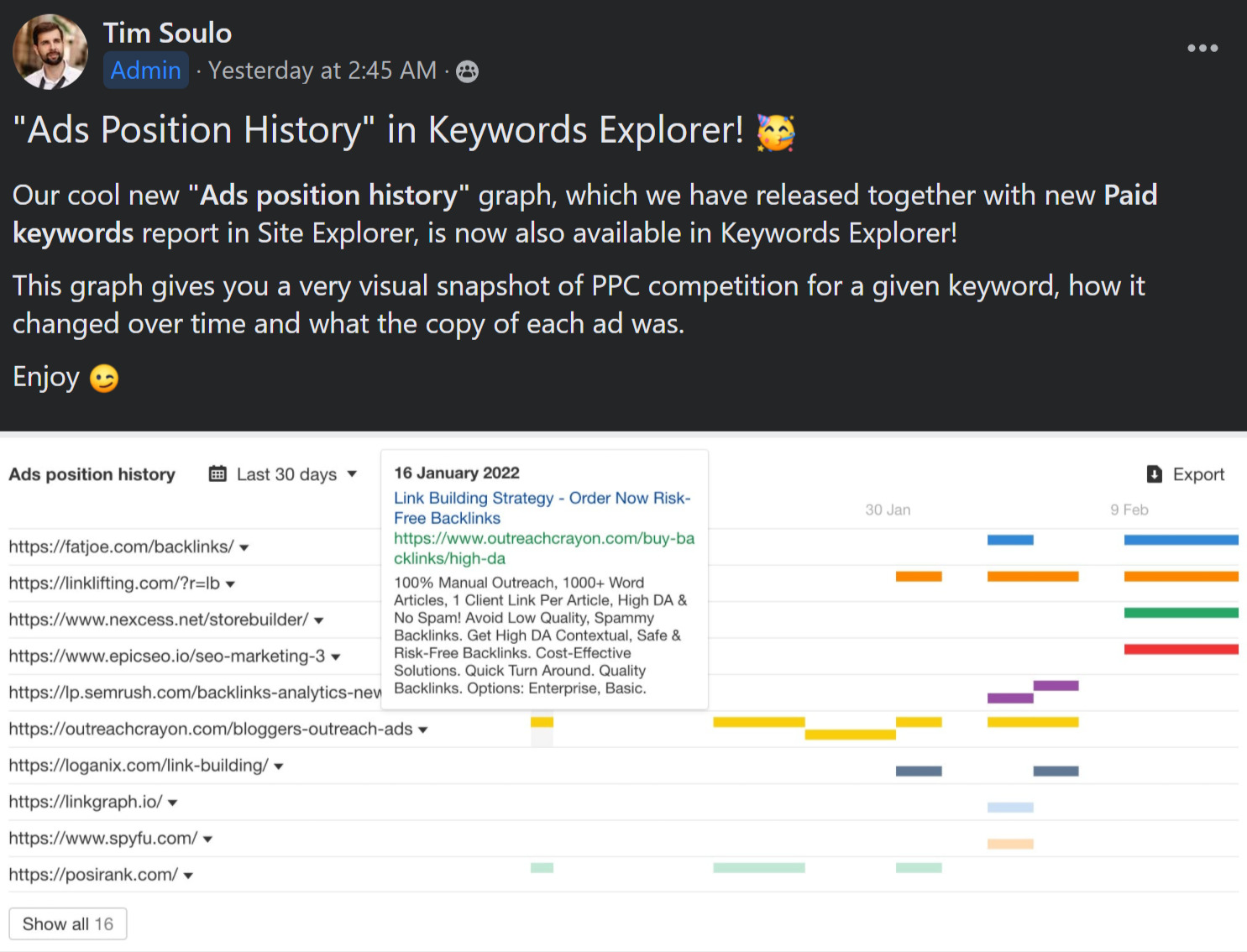
Or driving product adoption:

Or just answering a question:
Pretty simple methodology. For every keyword in the database we see a page ranking for, we take the search volume and estimated CTR data to calculate the traffic coming from that term. It typically undercounts because we may not have some really long tail or unpopular terms.
— Patrick Stox (@patrickstox) January 6, 2022
All these are examples of product marketing done within a community. Communities like these are often self-sustaining but shouldn’t be left alone.
Product marketing’s role in this scope is to make sure the community gets accurate information and is aware of new product developments.
As a “by-product” of that, people get better at using the product. Hence, they’ll likely use it more and will be more likely to recommend it to others.
4. User onboarding
User onboarding (aka product onboarding) is a stage within the product adoption process. It’s when a user is actively introduced to the features of the product. It’s an important stage of the process.
This is because the messaging that made the user sign up for the product won’t be enough to make them know how to use the product. And only users who know how to use the product (but not necessarily all of its features) can become satisfied customers.
User onboarding typically refers to the first steps users take “inside” the product—a sort of “showing the user around.”
For product adoption to be successful, users need to understand the value of the product as soon as possible.
So the goal of the product marketer is to get users to the so-called “aha-moment” quickly and smoothly.
A tried and tested technique of user onboarding is to send automated email workflows, which are triggered immediately after the user signs up for the product.
There are different “styles” of doing this. We try to keep it short with only three messages and include the most important information inside the first.

Excerpt from Ahrefs welcome email.
This email above shows the user that we’ve got their back and have prepared more than enough educational materials to show them how they can become more successful, thanks to our product.
Since our product can be quite intimidating to newcomers (lots of data), we also include contextual help in the form of tooltips. These tooltips explain how to use the different reports and the meanings of the metrics inside them.

5. Product education
Beyond user onboarding, we have “regular” product education and support.
For us, it’s a stage where product adoption blends with generating demand because nearly all of our content is product-led.
This means the same materials used for user education in one channel can be, at the same time, the materials that drive visitors to us through organic search.
For example, a paying customer looks for a step-by-step tutorial on how to build links to their site and finds this article on our blog. Yet, everyone else can access the same article through a search engine like Google.

Our guide to link building for SEO drives an estimated 5.4K organic visits per month. Data via Ahrefs’ Site Explorer.
This brings us to our knowledge base, another outcome of marketing a product. They don’t need a special introduction; with it, we aim to maximize product adoption as other companies do.
On a side note, it’s likely no product-led content marketing can substitute the good ol’ knowledge base.
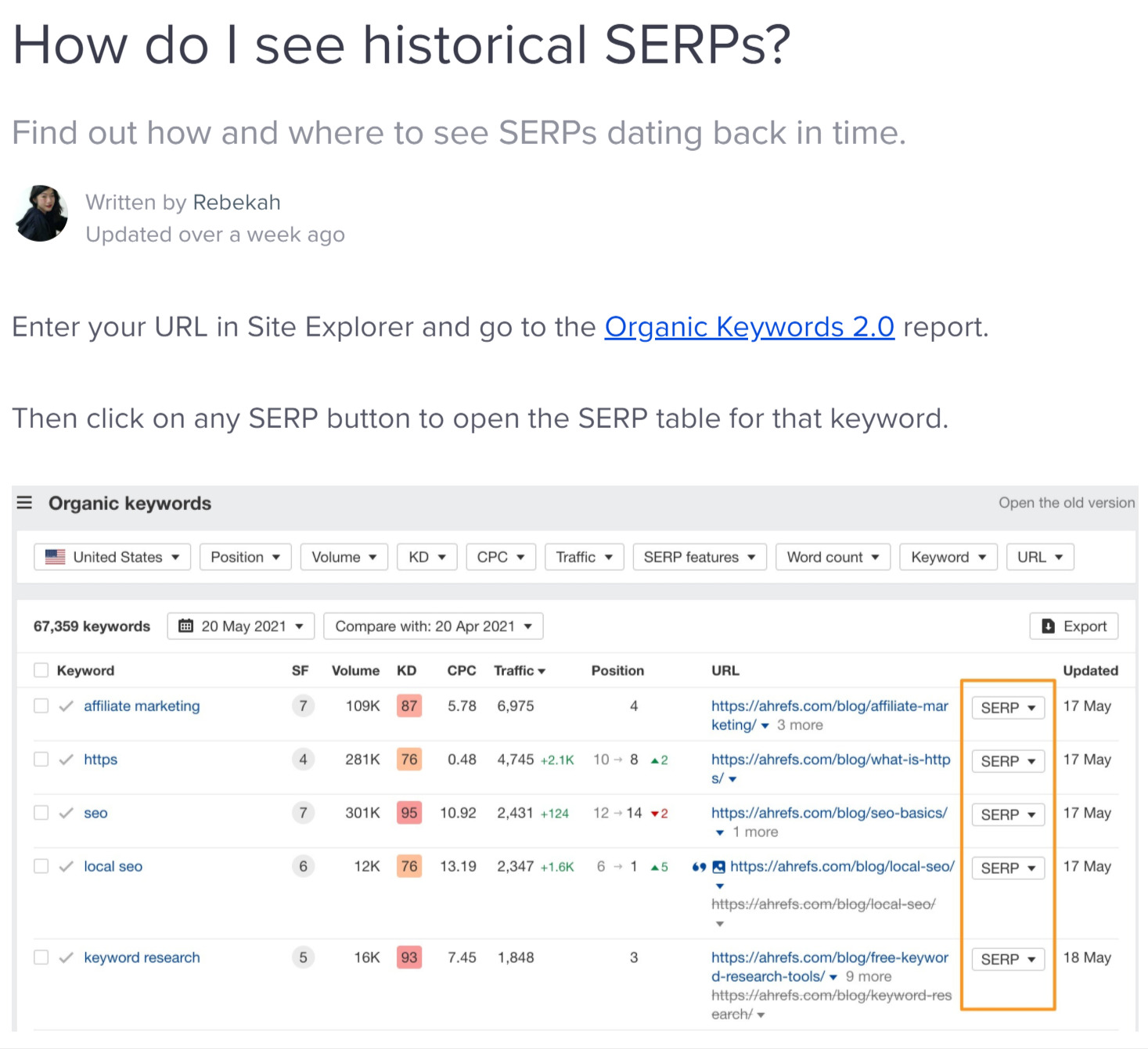
Did someone say historical SERPs in Ahrefs? Sure, here’s how.
That said, product education for a set of tools like Ahrefs requires something more than letting users discover educational content through search. It needs an organized curriculum. This is why we built the Ahrefs Academy. It’s packed with helpful video tutorials and is completely free.

One of the courses from the Ahrefs Academy. Everybody can learn how to use Ahrefs in a step-by-step, self-paced course.
6. Gathering user feedback
No matter how visionary your product is, you can’t ignore user feedback. In fact, there is a popular notion that you should ship your product fast (even if it’s not perfect) just to learn if you’ve got a product that shows enough potential (see value hypothesis).
At Ahrefs, we gather feedback on our product in three ways:
- An always-on customer feedback management platform
- Agile, bite-sized surveys
- Interviews with customers (sporadically)
Let’s take a quick look at the first two methods.
For the first method, we use Canny. It’s an open platform that lets users share their ideas on improving Ahrefs, comment on those ideas, and vote on them. So not only can we learn about others’ ideas, but we can also know how many people share those views.

For the second method, we usually ask our community at Ahrefs Insider. Unlike Canny, this is a group (currently on Facebook) available to only paying users. We get important feedback through that channel, and we do listen to it:
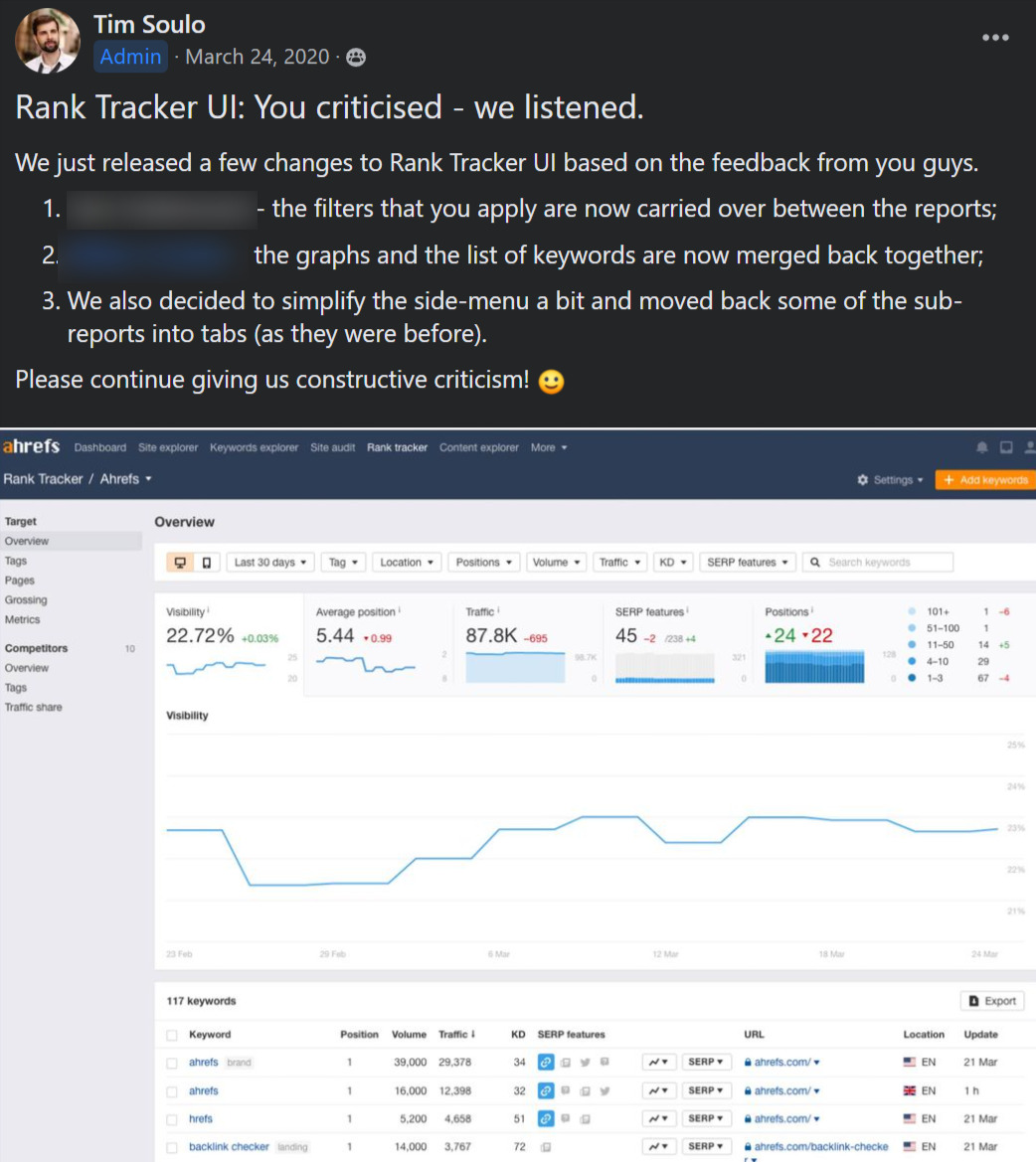
On top of that, every two years (on the same day), we ask this question openly on Reddit:
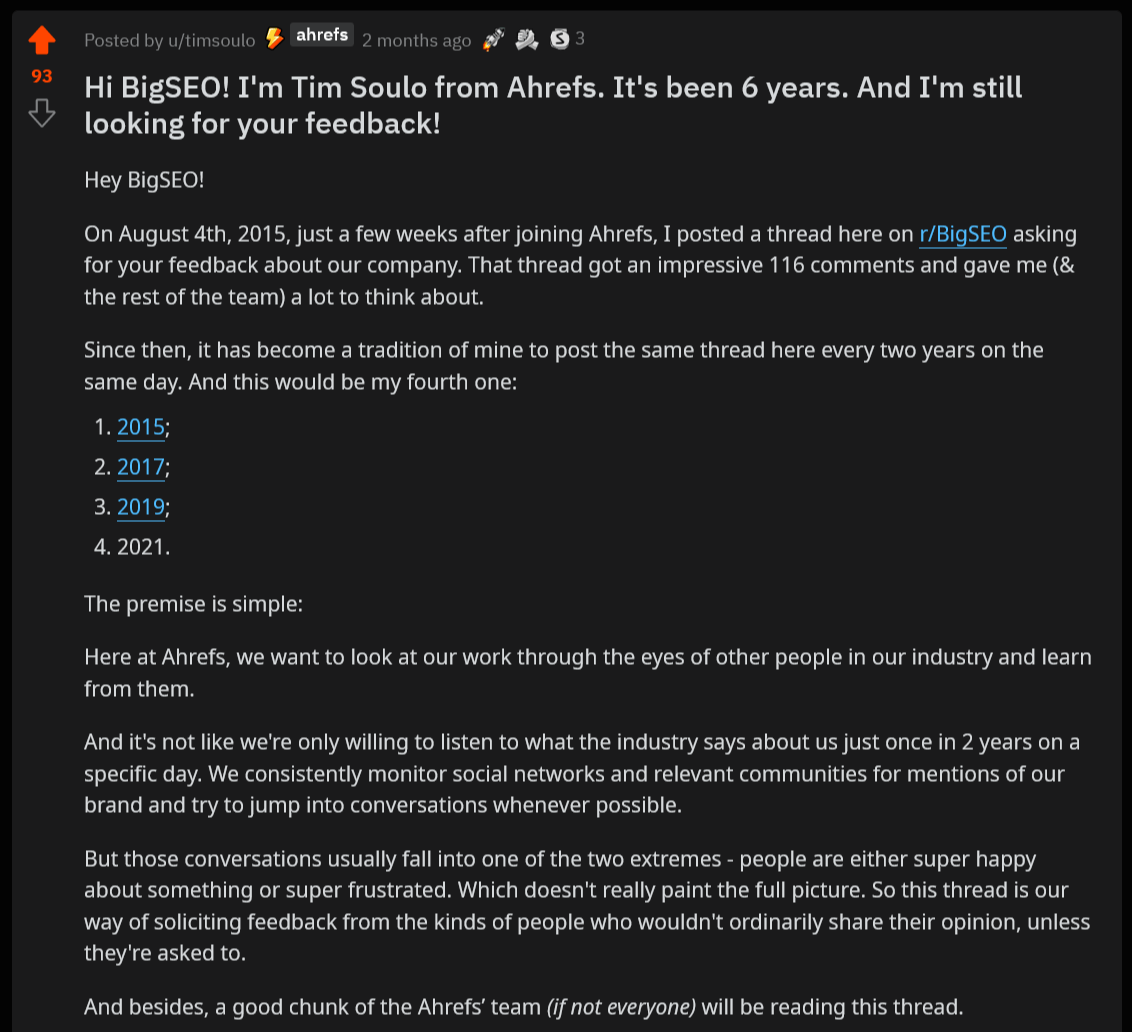
7. Homepage design
Last but not least, let’s look at Ahrefs’ product messaging on the homepage.
Creating a homepage that shapes brand and product communication is tough, and it’s also part of a product marketer’s job. It’s supposed to educate, entertain, and convert at the same time.
Let me give the floor to Ahrefs CMO Tim Soulo, who made a video to explain how we created Ahrefs’ current homepage. It talks about:
- Why we expanded our communication to the “problem-aware” audience.
- How we decided to explain Ahrefs to newcomers.
- Why extending the customer journey on purpose is sometimes a good idea.
Final thoughts
Marketing a product can’t be done without product marketing. It even sounds quite self-explanatory. If you’re doing a good job at marketing, you’re probably also doing a good job at product marketing.
I have a feeling that some 30 years ago, product marketing would be called just “marketing.” It’s just that in recent years this set of marketing activities has been extracted from a bigger set and given an identity of its own. And it’s no wonder. Marketing has been burgeoning with specializations for years.
Does every marketing team need a product marketer? Sooner or later, probably yes. But does every marketing team need product marketing? Definitely.



